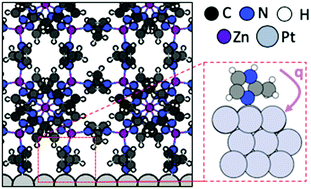Electronic effects due to organic linker-metal surface interactions: implications on screening of MOF-encapsulated catalysts†
Abstract
MOF-encapsulated nanoparticles (NP@MOFs) are hybrid, heterogeneous catalysts, where the MOF could boost the activity and selectivity of the encapsulated NP for the reaction of choice by controlling reactant orientation. However, due to overwhelming combinatorics, methods to rapidly identify promising NP + MOF combinations for a given application are needed. Earlier work used a “surrogate” inert pore on top of NP-representative surfaces to generically capture MOF steric effects, hence enabling computational screening to focus on NP composition. However, the surrogate pore method neglects electronic effects of the MOF on the NP. Here, we use density functional theory to study how paradigmatic MOF linkers (imidazolate, carboxylate, and thiolate) impact the electronic structure of representative metal surfaces, and in turn the binding of small species, whose formation energies are commonly used in descriptor-based catalyst screening. We find that the coordinating moiety and functionalization of the linker modulates the shift in the metal d-band center and the electron transfer, which is correlated to experimentally measurable quantities such as C–O vibration frequencies. However, in the majority of cases, the effect of the linker on binding energies (for C*, O*, N*, H*, OH*, CH3* and CO*) was less than 10 kJ mol−1. Furthermore, scaling relationships between binding energies were only slightly affected by linker-originated electronic effects. Therefore, activity/selectivity “heat maps” derived from calculations under “generic” steric constrains could remain useful to screen the optimal NP composition of an NP@MOF catalyst. On the other hand, the placement of a given NP composition on the aforementioned heat maps is affected by the MOF. For an n-butane oxidation case study, we estimated that Ag3Pd—a promising NP composition for selective 1-butanol formation according to previous screenings using the surrogate pore method—has a ∼85% probability of retaining a selectivity for 1-butanol above 75% when encapsulated in a carboxylic MOF of suitable pore size.



 Please wait while we load your content...
Please wait while we load your content...